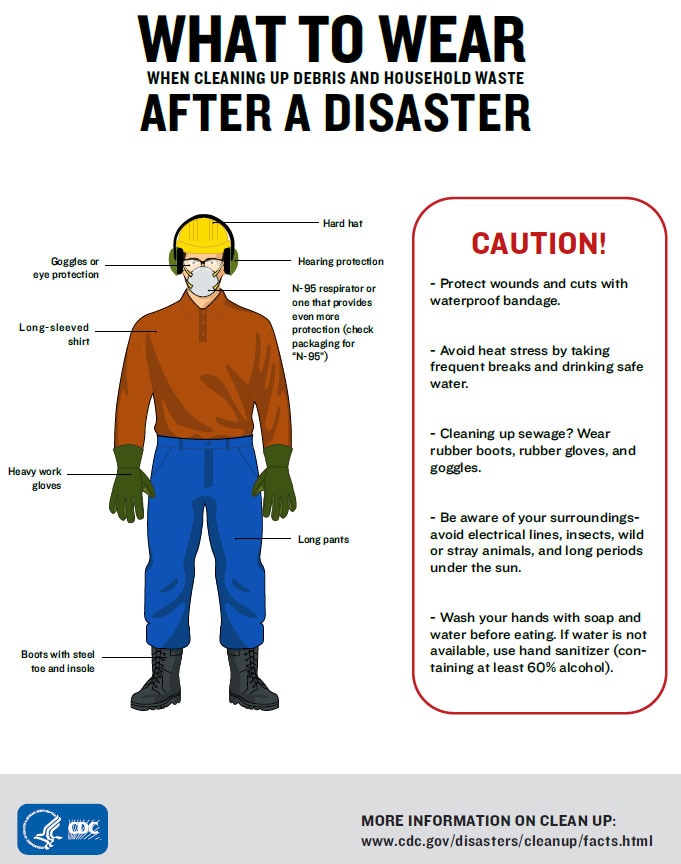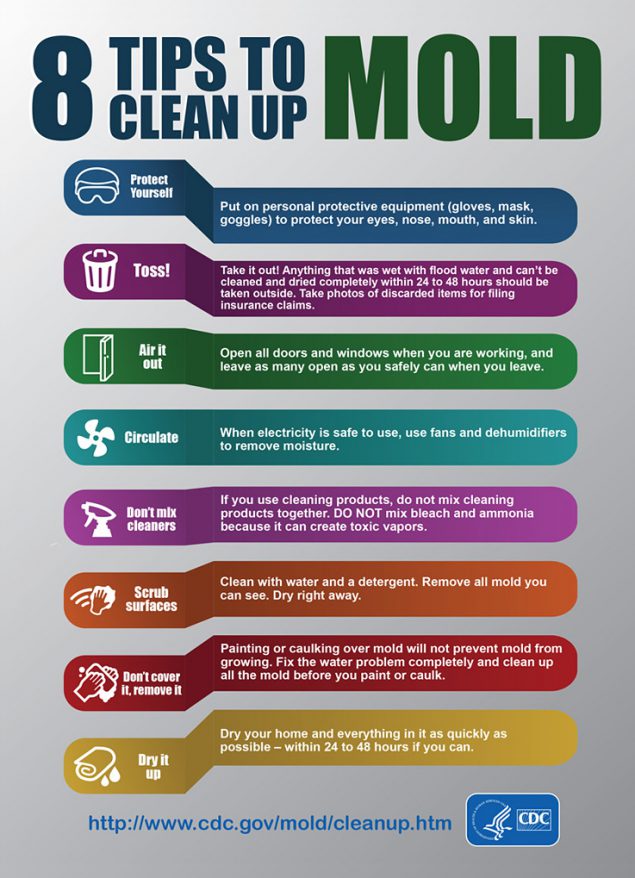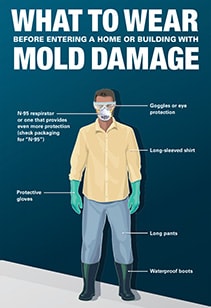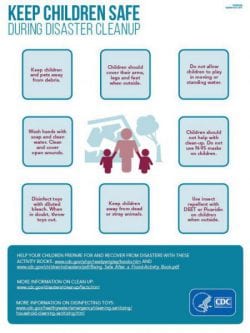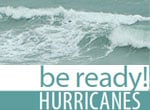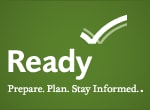Clean Up Safely After a Disaster

Take steps to protect yourself and your loved ones during your cleanup after a hurricane, flood, or other natural disaster. Follow our cleanup tips and monitor your radio or television for up-to-date emergency information.
General Safety Tips
Get the right safety gear
- Hard hats
- Goggles
- N95 masks (or a respirator with a higher protection level)
- Heavy work gloves
- Waterproof boots with steel toe and insole (not just steel shank)
- Earplugs or protective headphones (if you’re working with noisy equipment)
- At least two fire extinguishers (each with a UL rating of at least 10A)
If sewage is involved, make sure to wear the following during your cleanup:
- Rubber boots
- Rubber gloves
- Goggles
Use teams to move heavy/bulky objects
- Have teams of at least two people work together to move heavy or bulky objects.
- Avoid lifting any material that weighs more than 50 pounds (per person).
Pace yourself
Cleaning up your home can be a big job. Be sure to take care of yourself:
- Rest when you need to.
- Decide which cleanup tasks are most important, and focus on those first. That way, you’re less likely to be overwhelmed.
- Get help lifting heavy or bulky objects. If you lift too much on your own, you could hurt yourself.
- Try to work with other people, so you aren’t alone.
- Get support from family members, friends, counselors, or therapists.
Take precaution when using a chainsaw
- When using a chain saw, always follow manufacturer’s instructions. Make sure to wear appropriate protective gear, and be sure that bystanders are a safe distance away.
- Avoid contact with power lines, and take extra care in cutting trees or branches that are bent or caught under something else.
- Use extreme caution to avoid electrical shock when using an electric chain saw.
- For tips on safely operating a chain saw, see Preventing Chain Saw Injuries During Tree Removal After a Disaster.
Stay safe in hot weather
- In hot weather, try to stay cool by staying in air-conditioned buildings, taking breaks in shaded areas or in cool rooms, drinking water and nonalcoholic fluids often, and wearing light and loose-fitting clothing.
- Do outdoor activities during cooler hours.
- For more information on protecting yourself against heat-related illness, see the CDC Extreme Heat Web site .
Mold
Prevent mold growth
- Clean up and dry your home quickly after the storm or flood ends- within 24 to 48 hours if possible.
- Air out your house by opening doors and windows. Use fans to dry wet areas. Position fans to blow air out doors or windows.
- Throw away anything that you can’t clean or dry quickly (such as mattresses, carpeting, carpet padding, rugs, upholstered furniture, cosmetics, stuffed animals, baby toys, pillows, foam-rubber items, books, wall coverings, and paper products).
- Remove and discard drywall and insulation that has been contaminated with sewage or flood waters.
- Thoroughly clean all wet items and surfaces with hot water and laundry or dish detergent. For example, you’ll want to clean any flooring, concrete, molding, wood and metal furniture, countertops, appliances, sinks, and other plumbing fixtures.
- Fix any leaks in roofs, walls, or plumbing as soon as you can.
Clean up mold with a mix of bleach and water
- Never use bleach in a closed space. Open windows and doors first.
- Put on personal protective equipment to protect your eyes, nose, mouth, and skin. Wear goggles, an N-95 respirator, and protective gloves.
- To make your cleaner, mix 1 cup of household bleach with 1 gallon of water.
- Clean everything with mold on it.
- See Mold After a Disaster, CDC Flood Web site, and Homeowner’s and Renter’s Guide to Mold Cleanup After Disasters or more information on safely reentering flooded homes, cleaning up flood or storm water, worker safety issues, and mold cleanup issues.
Hygiene & Preventing Diseases
Disinfect toys
Remember that anything that’s had contact with floodwater could carry germs. To keep your kids safe, make sure their toys are clean:
- Make a cleaning fluid by mixing 1 cup of bleach in 5 gallons of water.
- Wash off toys carefully with your cleaner.
- Let the toys air dry.
You may not be able to kill germs on some toys — like stuffed animals and baby toys. Throw out toys you can’t clean.
Wash up with soap and water
- Wash up with soap and water once you’re done cleaning.
- If there is a boil-water advisory in effect:
- Use water that has been boiled for 1 minute (allow the water to cool before washing); or
- Use water that’s been disinfected for personal hygiene:
- Use 5%-9% unscented liquid household chlorine bleach – add a little less than 1/8 teaspoon (8 drops or about 0.5 milliliters) per 1 gallon of clear water. Stir well, and let it stand for 30 minutes before using. If the water is cloudy, add a little less than ¼ teaspoon (16 drops or about 1 milliliter) per 1 gallon of water.
- If you have any open cuts or sores that were exposed to floodwater, wash them with soap and water and apply an antibiotic ointment to prevent an infection.
- Seek immediate medical attention if you become injured or sick.
- Wash all clothes worn during the cleanup in hot water and detergent. These clothes should be washed separately from uncontaminated clothes and linens.
- For more tips on washing your hands, see Clean Hands Save Lives: Emergency Situations.
Be careful with floodwater- it can contain dangerous bacteria
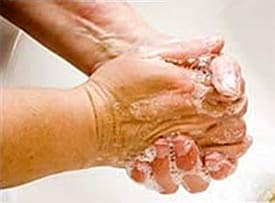
- Floodwater can contain dangerous bacteria from overflowing sewage and agricultural and industrial waste. While skin contact with floodwater doesn’t pose a serious health risk by itself, eating or drinking anything contaminated with floodwater can cause diseases.
- If you have any open cuts or sores that will be exposed to floodwater, keep them as clean as possible by washing them with soap and applying an antibiotic ointment to discourage infection. (See also Clean Hands Save Lives: Emergency Situations)
- To reduce cold–related risks when standing or working in water which is cooler than 75 degrees F (24 degrees C), wear insulated clothes and insulated rubber boots, take frequent breaks out of the water, and change into dry clothing when possible.
- See also Food, Water, Sanitation, and Hygiene Information for Use Before and After a Disaster or Emergency and Reentering Your Flooded Home.
Potential Hazards
Be careful when entering damaged buildings
- Stay away from any damaged buildings or structures until a building inspector or other government authority has had a chance to examine it and certify that it’s safe.
- Wait until daylight to return to buildings so it’s easier to see and avoid any hazards- especially if the power is out.
- Leave your home or other building if you hear any shifting or strange noises- this could mean it’s about to fall.
- If you smell gas or suspect a leak, leave your house/building and contact emergency authorities right away! Don’t turn on the lights, light matches, smoke, or do anything that can cause a spark. Don’t return to the building until you’re told it’s safe to do so.
- Keep children and pets away from the affected area until cleanup has been completed.
Prevent carbon monoxide poisoning
- Never use generators, pressure washers, or other gasoline, propane, natural gas, or charcoal-burning devices inside your home, basement, garage, or camper—or even outside near an open window, door, or vent. Carbon monoxide—an odorless, colorless gas from these sources that can cause sudden illness and death—can build up indoors and poison the people and animals inside.
- For more information, see Carbon Monoxide Poisoning After a Disaster.
Be aware of any electrical hazards
- If electrical circuits and electrical equipment have gotten wet or are in or near water, turn off the power at the main breaker or fuse on the service panel. If you must enter standing water to access the main power switch, then call an electrician to turn it off.
- Never turn power on or off or use an electric tool or appliance while standing in water.
- Do not connect generators to your home’s electrical circuits without the approved, automatic-interrupt devices. If a generator is on line when electrical service is restored, it can become a major fire hazard and it may endanger line workers helping to restore power in your area.
- For more information, see Protect Yourself and Others from Electrical Hazards After a Disaster.
Be careful with dangerous materials
- Call the fire department to inspect or remove chemicals, propane tanks, and other dangerous materials.
- Wear protective clothing and gear (for example, a respirator if needed) when handling hazardous materials.
- Wash skin that may have come in contact with hazardous materials.
- Wear insulated gloves and use caution if you have to remove a car battery. Avoid any acid that may have leaked from a car battery.
- For information about possible dangers posed by chemicals, see the Chemical Emergencies page.
- For information about possible dangers posed by pollution from large farms and agricultural facilities, see the CDC Concentrated Animal Feeding Operations (CAFOs) website.
Page last reviewed: September 20, 2021
